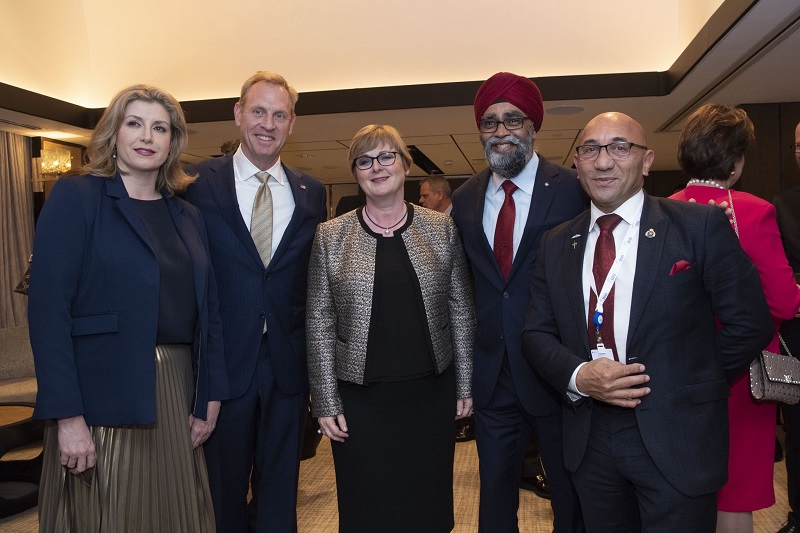
The Shangri-La Dialogue is speed dating for defence ministers.
Singapore has just hosted the 18th annual version of this defence dance done with summit trappings.
The 22 ministers were a sizeable grouping of stars. Then add in military brass wearing uniforms from across the Indo-Pacific, Europe and North America.
Plenty of generals and admirals add visual glitter to the criss-crossing parade of delegations darting across the Shangri-La hotel foyer—disciplined schools of fish flitting to meetings.
The sherpas shepherd ministers and generals through myriad bilaterals, coffee conferences, quick jousts with journalists, the big plenary speech, and constant talking at breakfast, lunch and dinner.
Dances can be exhausting, especially with many different tunes.
The man driving the dialogue every year since its 2002 debut is the director-general of the International Institute for Strategic Studies, Dr John Chipman. He says it ‘gives defence ministers the opportunity to sit down and talk about strategy and intentions. The hundreds of intense diplomatic exchanges planned at the summit will have strategic impact far beyond this weekend.’
The on-the-record plenaries in the giant ballroom are where the dance is both formal and free-form.
The minister delivers a set speech; then they’re on their own for the Q and A. Some questions are soft balls, others are sharp rocks.
Chipman chairs every session, an urbane Brit who gives instant speech analysis, marshals questions, and can politely remind a minister they haven’t quite answered. His voice, polite but probing, is a constant thread through 18 Shangri-Las.
China still grapples with the dialogue. In the early years, Beijing was deeply suspicious of an Asian defence summit run by a London-based think tank (although in imitation/competition mode, China has established its own version of Shangri-La).
China’s suspicion of the Anglo-flavoured event was heightened in 2004 when Donald Rumsfeld, as US secretary of defence, started the American custom of turning up at Shangri-La to make a splash.
Whatever the Singapore government pays IISS, it’s a bargain—a small defence diplomacy investment delivering big returns.
Every year, the US defence secretary’s jumbo jet lands in Singapore. Other defence ministers flock. Singapore built its own annual military summit, gaining soft-power kudos hosting all these people responsible for hard power.
One conference tradition is that the US defence secretary occupies the first session on Saturday. This year, for only the second time, China sent its defence minister, for a mirror session on Sunday—a face-off that framed Shangri-La and will dominate many future dances.
Australia is a foundational Shangri-La enthusiast. Robert Hill, Oz defence minister from 2001 to 2006, saw the potential and grabbed it.
Australia’s defence minister has been at 17 of the 18 dialogues. The only exception was the 2016 federal election when Defence Minister Marise Payne wouldn’t leave her Parramatta command post, fighting across western Sydney for the narrowest of victories for the Turnbull government.
This year, Australia’s new defence minister, Senator Linda Reynolds, who was sworn in on Wednesday, was in Singapore by Friday.
As Reynolds noted, 75% of her time as defence minister had been spent at Shangri-La. Along with her bilaterals, Reynolds attended a meeting of ministers of the Five Power Defence Arrangements and a trilateral with the US and Japan. The trilateral joint statement embraced the US Indo-Pacific strategy report, released to coincide with Shangri-La.
Reynolds was at the head of a hefty delegation, including Defence Secretary Greg Moriarty, Chief of the Defence Force General Angus Campbell, and Foreign Affairs and Trade Secretary Frances Adamson.
After the ministerial plenaries, breakout sessions enabled Moriarty to speak on defence industry, Campbell on new patterns of defence cooperation, and Adamson on South Pacific strategic competition.
The Oz delegation’s march across the foyer was impressive. The first woman in the Australian Army Reserves to be promoted to brigadier, Reynolds knows about parade-ground impact. After her speech, I told the minister that her delegation turnout matched China’s and got an emphatic, smiling nod.
Reynolds’s speech used Australian mateship as the theme: ‘Mateship isn’t just about connections and trust, it’s about giving others a fair go.’ Trust is based on rules and behaviour, leading to Reynolds’s substantial argument for the rules-based order in the Indo-Pacific.
Some Australians cringed at the mateship usage. I loved it as a speech hook for a new minister introducing herself. Vivid stuff, well delivered, is what Shangri-La demands.
Shangri-La custom is that ex-ministers come back to join the audience. One of the Australians applauding Reynolds was Stephen Smith.
Smith thinks the Shangri-La mood has become tougher than when he was defence minister, from 2010 to 2013. Back then, he says, ‘There was an atmosphere of exchange of views, exchange of ideas, doing things together. But as strategic competition between the US and China has risen, so has the sharpness of the issues that are addressed here.’
He says Shangri-La is a great opportunity for Australia to do a lot over a weekend, to get a feel for the thinking of many different players, and ‘to reinforce the notion that Australia is an Indo-Pacific power, we live and breathe the Indo-Pacific’.
Shangri-La is still working, Smith comments, it’ll just need to work harder: ‘Despite the fraughtness of some of the issues, you do get the chance of having relaxed private conversations with key counterparts.’

